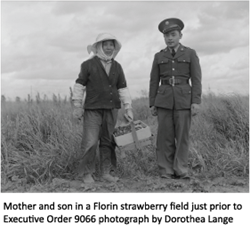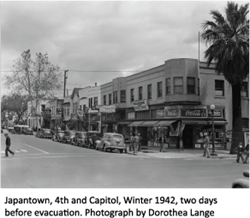"February 19 is a significant date for the Japanese American community. On this day in 1942, President Franklin D. Roosevelt signed Executive Order 9066, which gave the U.S. Army the authority to remove civilians from the military zones established in Washington, Oregon, and California during WWII. This led to the forced removal and incarceration of some 120,000 Americans of Japanese ancestry living on the West Coast, who had to abandon their jobs, their homes, and their lives to be sent to one of ten concentration camps scattered in desolate, remote regions of the country" (Japanese American Citizenship League).
By pausing as a collective community and observing the Day of Remembrance of Japanese Internment, the Japanese American Citizens League believes that it provides “an opportunity to educate others on the fragility of civil liberties in times of crisis, and the importance of remaining vigilant in protecting the rights and freedoms of all.”
 The very first Japanese settlement in the United States, Wakamatsu Colony, was established near Placerville in 1869. By the turn of the century, nearly 30,000 more dekasegii, or “birds of passage,” had left Japan for America. By 1930, 75 percent of the nation’s Japanese Americans lived in California with major enclaves in Fresno, San Francisco, Los Angeles and Sacramento. Through the Gilded Age and into the Interwar period, California’s Japanese Americans flowered, building solid communities and contributing mightily to the agricultural, cultural and intellectual vibrancy of the Golden State.
The very first Japanese settlement in the United States, Wakamatsu Colony, was established near Placerville in 1869. By the turn of the century, nearly 30,000 more dekasegii, or “birds of passage,” had left Japan for America. By 1930, 75 percent of the nation’s Japanese Americans lived in California with major enclaves in Fresno, San Francisco, Los Angeles and Sacramento. Through the Gilded Age and into the Interwar period, California’s Japanese Americans flowered, building solid communities and contributing mightily to the agricultural, cultural and intellectual vibrancy of the Golden State.
 And yet, racism and xenophobia were never too far away, accented by exclusionary legislation (1924), restrictive covenants (1913/20 Alien Land Law), and other forms of racism, both random and systematic. After the December 7, 1941 attack on Pearl Harbor, Hawaii, Executive Order 9066 of February 1942 made legal the forceful removal of Americans of Japanese descent. In Sacramento that meant the internment of 5,000 Americans, including 450 families from the Florin District of Sacramento County and thousands from the veritable beating heart of Japanese American culture in the Sacramento Valley in the Capital City’s Japantown neighborhood. In the words of venerable Sacramento historian Joseph McGowan, “[Internment was] one of the most tragic, unnecessary, and unjust actions in the state’s history, but few seemed to recognize this fact at the time” (History of the Sacramento Valley, page 311).
And yet, racism and xenophobia were never too far away, accented by exclusionary legislation (1924), restrictive covenants (1913/20 Alien Land Law), and other forms of racism, both random and systematic. After the December 7, 1941 attack on Pearl Harbor, Hawaii, Executive Order 9066 of February 1942 made legal the forceful removal of Americans of Japanese descent. In Sacramento that meant the internment of 5,000 Americans, including 450 families from the Florin District of Sacramento County and thousands from the veritable beating heart of Japanese American culture in the Sacramento Valley in the Capital City’s Japantown neighborhood. In the words of venerable Sacramento historian Joseph McGowan, “[Internment was] one of the most tragic, unnecessary, and unjust actions in the state’s history, but few seemed to recognize this fact at the time” (History of the Sacramento Valley, page 311).
Special thanks to Librarian James Scott (Sacramento Room), for gathering the research, photographs, and resources documenting the Japanese American experience in the Sacramento region.
About the Japanese American Citizenship League:
“Founded in 1929, the JACL is the oldest and largest Asian American civil rights organization in the United States. The JACL monitors and responds to issues that enhance or threaten the civil and human rights of all Americans and implements strategies to effect positive social change, particularly to the Asian Pacific American community.”
The following #OwnVoices book lists were developed by the Sacramento Public Library’s Equity, Diversity, and Inclusion Team. #OwnVoices specifies authors from under-represented and marginalized groups, who write from their own perspective and experiences. Author Corinne Duyvis is credited for starting the #OwnVoices movement in 2015.
Reading Recommendations for Kids, Teens and Adults
#OwnVoices book selections for kids, including picture books, children’s fiction, children’s graphic novels, and children’ non-fiction.
Resources
Resources about local history and experience, recommended by James Scott, Librarian, Sacramento Room.

Sacramento's Historic Japantown: Legacy of a Lost Neighborhood by Kevin Wildie and numerous interviews with residents of Japantown
Wildie, a professor with the Los Rios College District, uses oral histories with numerous residents of Sacramento's Japantown to put together the fullest history done of the gone but far from forgotten ethnic enclave.
Growing Up in Florin by Florence Kawagoye
Kawagoye provides a detailed description of the days immediately after the attack on Pearl Harbor and its massive, life-altering impacts on her entire family and what had been the thriving community of Florin. Beautifully written and emotive throughout. Copies in the Sacramento Room and available electronically through request to jscott@saclibrary.org.
Walerga Wasp, Jobo Nakamura (editor)
The camp newspaper for displaced Americans living at the Walerga Assembly Center (near present day North Highlands) in the spring/summer of 1942, prior to their relocation to Tule Lake. All issues of this remarkable window into American life under the impacts of total war can be read by going to www.saclibrary.org/digitalarchive.
 Kiyo's story: a Japanese-American family's quest for the American dream by Kiyo Sato
Kiyo's story: a Japanese-American family's quest for the American dream by Kiyo Sato
What is like to return to your childhood home and find a complete stranger living there? Rancho Cordova native Kiyo Sato recounts her coming of age in Sacramento in the face of Internment through this autobiographical work. Sato, a veteran, inventor and medical clinician won the prestigious William Saroyan Writing Prize with Kiyo's Story.
Changing dreams and treasured memories: a story of Japanese Americans in the Sacramento region by Wayne Maeda and Sacramento Japanese American Citizens League
The most comprehensive #OwnVoice history written on the Japanese American experience in the Sacramento Region. From Wakamatsu Colony to the post-Internment fight by many to wrest their lives and rights back, Maeda's work covers all of the bases.
Additional reading recommended by Sacramento Public Library’s AccessABILITY, Equity, Diversity, and Inclusion Committee:

Historian Erika Lee addresses past and present-day discrimination toward Native-American, African-American, Chinese-American, Japanese-American, and Mexican-American communities. More than a fear of others, xenophobia is characterized by prejudice, animosity, and bias against immigrants; xenophobia promotes the belief that immigration and the movement of peoples are both a crisis and an invasion. This comprehensive work covers the recent treatment of asylum seekers at the Mexico/United States border, Islamophobia following 9/11, and xenophobic behavior and policies against Chinese and Chinese Americans during the COVID-19 pandemic.